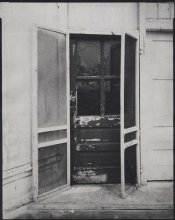Harrigan
Member
You guys and gals might be interested in this, or not
...
I was given a box of Haloid contact printing paper 8x10.5 semi matt surface grade 3 recently. The box is dated Feb 1958 and was pulled from a rear storage room. Who knows how this was stored for all these years but its not been ideal for sure. Haloid is of course the original name of Xerox so I find it amusing that I am printing on Xerox paper. Its also neat that I grew up a short bike ride from the facility where this was made. I hear Weston used to print on the Haloid paper? Well it is pretty neat to print on some of the same papers he might have used as well.
Anyway I tried ektaflo dev with my first test of the paper, just to make sure it was still viable. As it made an image I did up a tray of amidol gaf 113. I know I should have saved the sample but I immediately noticed the amidol was much muddier in the highlights and the blacks were cooler yet not really blacker to me. I ended up going back to the warm tone ektaflo because I dont like cold prints and it really was giving me more highlight separation, or so it seemed. Ektaflo also produces a very good dmax for a warm tone developer and I use it frequently on chloro-bromide papers.
Regardless I was able to get a decent prints out of the paper albeit a touch foggy in the white areas. I did not use any anti-fog agent because I dont have any. Its very interesting to me that a paper expired for almost 50 years is still able to produce any image at all. Granted this print is a bit flatter than I normally print but its 50 years expired!
I was given a box of Haloid contact printing paper 8x10.5 semi matt surface grade 3 recently. The box is dated Feb 1958 and was pulled from a rear storage room. Who knows how this was stored for all these years but its not been ideal for sure. Haloid is of course the original name of Xerox so I find it amusing that I am printing on Xerox paper. Its also neat that I grew up a short bike ride from the facility where this was made. I hear Weston used to print on the Haloid paper? Well it is pretty neat to print on some of the same papers he might have used as well.
Anyway I tried ektaflo dev with my first test of the paper, just to make sure it was still viable. As it made an image I did up a tray of amidol gaf 113. I know I should have saved the sample but I immediately noticed the amidol was much muddier in the highlights and the blacks were cooler yet not really blacker to me. I ended up going back to the warm tone ektaflo because I dont like cold prints and it really was giving me more highlight separation, or so it seemed. Ektaflo also produces a very good dmax for a warm tone developer and I use it frequently on chloro-bromide papers.
Regardless I was able to get a decent prints out of the paper albeit a touch foggy in the white areas. I did not use any anti-fog agent because I dont have any. Its very interesting to me that a paper expired for almost 50 years is still able to produce any image at all. Granted this print is a bit flatter than I normally print but its 50 years expired!



